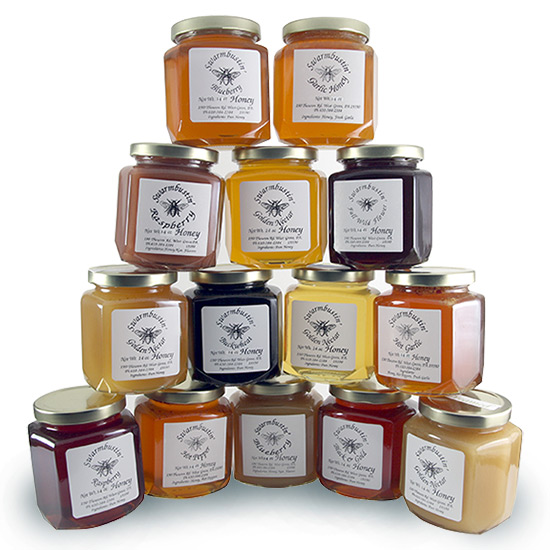
About Honey
Did you realize that honey is available in many different varieties? When bees visit mostly one kind of flower as they gather nectar, the honey they produce has a unique taste, aroma and color from that particular flower. Other honeys are delicious blends of floral sources.
Honey is a saturated solution of sugar made by bees that collect nectar which is a liquid secretion from flowers. The honeybees take this nectar back to their hives where they add enzymes to it and place it in wax cells called honeycombs. This is where it ripens to form honey. During the ripening process, the enzymes convert sucrose into glucose and fructose.
There are many different types of honey. The differences are predicated on the floral source. What most people don't know is that honey has the ability to kill bacteria and heal wounds because it is very acidic. In fact, many years ago, honey was frequently used for medical purposes. However, with the advent of antibiotics, medical professionals were under the misconception that they were more effective than honey. As antibiotics are proving to be less effective on certain types of infections, doctors are now reconsidering honey as a viable treatment solution.
 Honey, a pure, natural sweetener prepared by bees from nectar collected from wild and cultivated flowers, was the first sweetener known to man. It is frequently mentioned in the Bible and depicted in cave paintings from prehistoric times. Early civilizations, like the Greeks and Romans, called honey, "the nectar of the gods". It has been said that honey bees were not native to North America; and that early settlers brought bee colonies to the East Coast States. Native Americans termed them the "white man's fly".
Honey, a pure, natural sweetener prepared by bees from nectar collected from wild and cultivated flowers, was the first sweetener known to man. It is frequently mentioned in the Bible and depicted in cave paintings from prehistoric times. Early civilizations, like the Greeks and Romans, called honey, "the nectar of the gods". It has been said that honey bees were not native to North America; and that early settlers brought bee colonies to the East Coast States. Native Americans termed them the "white man's fly".
When bees have access to large areas of one kind of flower, such as locust blossom, tulip poplar, clover, basswood, goldenrod, or buckwheat, they produce honey with a flavor and color typical of that particular plant. Bees also make natural blends of honey from many different flowers in areas where no one flower predominates. Honeys are also blended during packing to produce a pleasing taste combination that can bee duplicated throughout the year.
To make honey from nectar, honey bees evaporate much of the moisture and add compounds called enzymes that change the composition of the nectar. Some of the complex sugars are broken down into simpler ones; and some of the sugar is converted into an edible acid called gluconic acid. This process helps to give honey it's distinctive taste. When the moisture content of the honey is reduced to about 17%, the bees fill the small cells of the comb and seal them with a white beeswax capping. We can then ?remove the sealed combs from the beehives to use them on our table as comb honey or to have them extracted for use as liquid honey. You need not worry about eating the wax with the honey because beeswax is a completely wholesome product.
Honey flavors range from mild and bland to strong and pungent. The color ranges from black to white. Pigment (color) begins in the nectar at the plant and is transported back to the hive. It is intensified by the natural process that the bees put it through (reducing the moisture level, etc.). Darker colored honey does not mean lesser quality; it means a different source of nectar and a different taste of honey. By trying different honeys, you can find the ones you enjoy most.

Types of Honey Are:
Totally Raw Honey:
Swarmbustin' Honey's Totally Raw honey has been extracted with no further processing. Depending on the floral source and the length of time between extracting and distributing, the honey may be liquid, but oft time it will bee crystallized
Liquid (extracted) Honey:
Liquid (extracted) honey is prepared by cutting off the wax cappings and whirling the comb in a honey extractor, where centrifugal force moves the honey out of the cells. Swarmbustin' Honey strains our liquid honey by running the honey through a series of strainers, as opposed to ultra heating and filtering.
Mountain Crème (granulated creamy) Honey:
Granulated creamy honey is made by blending one part finely granulated honey with nine parts liquid honey. The mixture is stored at about 57 degrees until it becomes firm.
Comb Honey:
Comb honey is honey-filled beeswax comb as stored directly by the bees.
Chuck Honey:
Chunk honey is comb honey in a jar with liquid honey poured around it.
